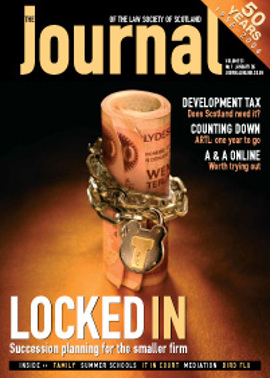KM in practice

When I mention that half my time in Bell & Scott is devoted to being KM partner the results are varied: glazed looks, puzzled frowns, incredulous gapes, hearty laughter, sympathetic noises; but, occasionally, genuine interest.
So what is the role of the KM partner?
Knowledge is the profession’s stock-in-trade, so it makes sense to manage it actively. That knowledge can be in many forms, such as published material, specially drafted material, work product and personal experience. It also extends across a wide range of areas, for example legal knowledge, client knowledge, industry knowledge and management knowledge. The core of the KM partner’s role is to take overall responsibility for planning and implementing the firm’s approach to capturing, creating, organising and sharing knowledge for the benefit of the business. Training is an integral part of knowledge sharing and therefore naturally falls within the KM partner’s remit.
Why a partner?
Of course it is not essential that a partner undertakes the role, but there are several advantages, including:
- signalling that the firm takes KM seriously;
- ensuring KM is integrated into top level decision-making; and
- allowing clout to be employed where necessary.
The KM partner does not actually need to implement; in fact he/she probably shouldn’t! Staff qualified in IT, information management and legal skills are invaluable – but leadership is critical.
How to do it
Begin by carrying out a “KM audit” to establish what KM activities are already happening (whether or not that’s what they are called). You may be surprised. This establishes your starting point. It’s easy to underestimate the value of this process. It will have side effects; for example, it may help you to understand what works well in your firm (or parts of it), and why – and what doesn’t. That is invaluable information for formulating a detailed strategy – which is the next step.
Forming a KM strategy
Why do you need a KM strategy? There are several reasons but, most importantly, it ensures your KM activities are aligned with the firm’s overall business aims; and it provides a framework for KM decisions.
Start with your firm’s business plan. (If you don’t have one, don’t waste time on KM – concentrate instead on deciding the firm’s business strategy first!) What does your business demand in terms of KM? The whole purpose of the strategy is to plan how best to harness, direct, develop and control knowledge to match the current and future needs of the firm and its clients.
One effective approach is to begin by drafting a vision for KM in the firm. This is more a compass than the “map” which the detailed strategy will become. Then look at the steps necessary to get from where you are now to realising the vision.
Of course there is no magic formula. By all means read the KM theories and the stories of their application in other industries, listen to the gurus, enquire about what is being done elsewhere – but then think. Strategy formulation should not be formulaic. Context and culture are critical.
My firm’s strategy does not match any other I have seen: I wouldn’t expect yours to either. However, I think the basics are: (1) know your firm; (2) have a vision; (3) build on successes; (4) be imaginative; (5) be realistic; (6) be flexible.
Getting going
Doing nothing until you have the perfect KM plan in place is not a viable option. You need to get going. Besides, experience of KM projects will inform the nascent plan. So, get some projects off the ground early – preferably including something which can be completed quickly to provide some encouragement.
Reality checks
But can it all be planned and controlled? KM is messy and, at times, frustrating, especially for those who like order, precision and control (like me!). Progress cannot always be smooth. Some projects will take on a life of their own and sprint past others. Some may be ideal but others may need to be curtailed before they devour resources better directed elsewhere. Some will stutter but should be nurtured. Others are best allowed to die. That is where flexibility comes in. And, without flexibility, imaginative use of knowledge is stifled.
So the role of the KM partner takes shape. Planning is at the heart of it but a balance must be maintained – planned progress without suffocation, room for creativity without chaos. Implementation involves monitoring and reinforcing the strategy, motivating others, persistence – and patience.
Bruce Anderson is Bell & Scott LLP’s KM partner and is the only partner in a Scottish law firm to have been awarded Nottingham Law School’s Diploma in Know-How Management for Legal Practice.
In this issue
- Pressing ahead
- Regulation, 2006 style
- Held to ransom?
- A world turned upside down
- Quiet revolutions
- For supplement read tax
- Why mediation is a bad idea, and other myths
- Advice in a Europe of many notions
- At the touch of a button
- What sort of courts do we want? (And when?)
- KM in practice
- If the bug bites
- Refreshing risk quiz
- The partnership must go on
- First duty to the court
- A difficult birth
- Nuclear power no thanks?
- Due diligence
- Will less mean better?
- Scottish Solicitors' Discipline Tribunal
- Website reviews
- Book reviews
- Back to the future
- Users' IT requirements for ARTL






